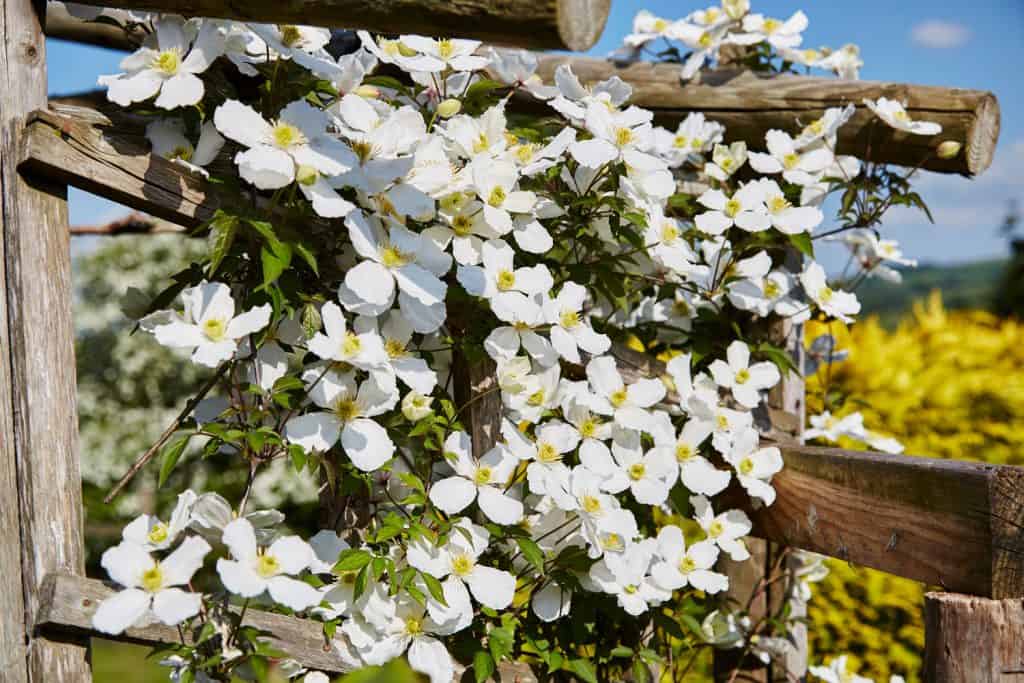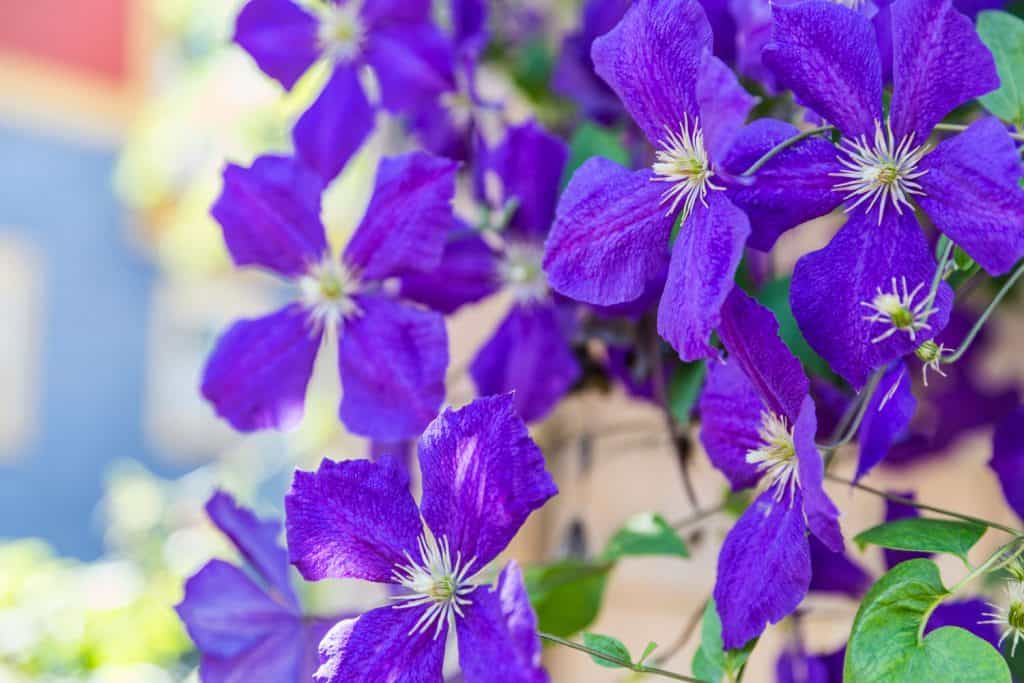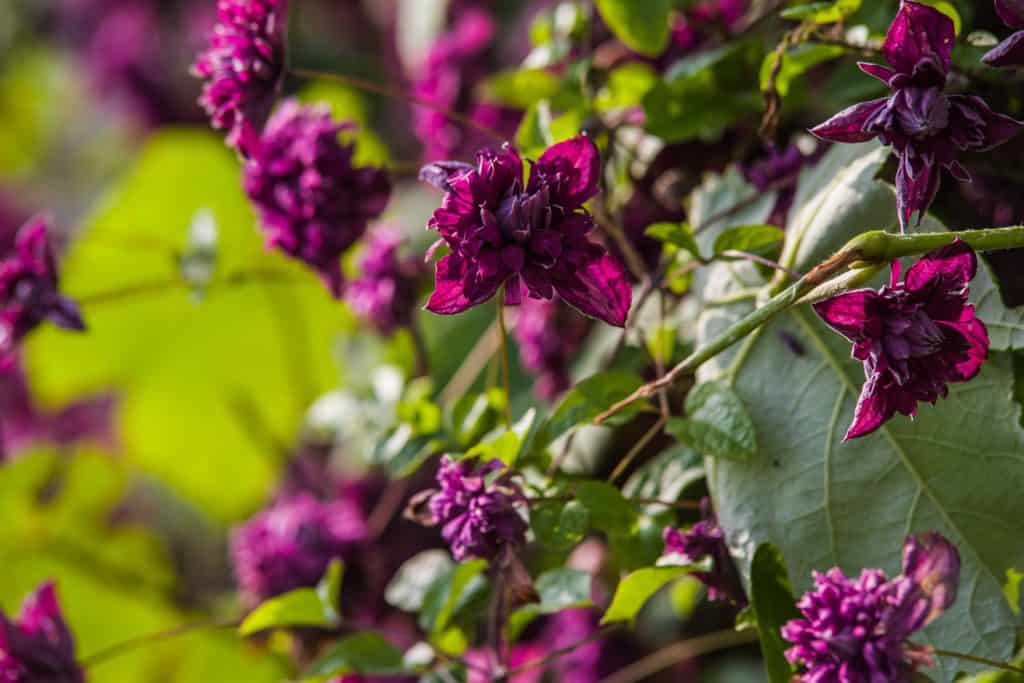Clematis plants are very popular additions to any garden. The versatility of these plants makes them highly sought after. Unfortunately, these beautiful plants can be difficult to move once planted. Despite the difficulty, it's still possible. We've done the research and can tell you when and how to transplant this genus of plant.
The best time to transplant clematis is in the early spring or the winter months. Choosing a time when your plant is dormant will cause less stress on the root system.
You should follow these steps when replanting your clematis:
- Prepare the location. Your soil should be slightly alkaline and moist. Dig a hole that is wide and deep. The hole will need to be able to fit in all of your plant's roots.
- Fill a bucket with water. You'll put your clematis in this bucket to transfer it to its new home.
- Trim your clematis to two feet above the ground.
- Dig a wide circle around your clematis. Remember, you want to maintain as much of the plant's root system as possible.
- Transfer your clematis to the bucket of water. Allow it to sit for about an hour before planting it again.
- Once ready, move your clematis into the prepared spot and slowly cover the roots.
- Gently pack the soil to avoid air pockets. Be sure to cover the crown and base shoots with a loose layer of soil.
Keep reading to learn if you can transplant clematis during the summer, what to plant next to them, and if two types of clematis can grow together.

Contents
How To Transplant Clematis
Clematis are among the more challenging types of plants to transplant. You can do it successfully as long as proper care is taken.

Select a Location
Before moving your clematis, make sure you have a spot selected. Pick an area with full sun to partial shade. You should also check your soil pH levels. Now will be the time to make any changes.
Dig the Hole
Once you select a location and your soil is amended, you can dig a hole. You need to dig an area that will be large enough to accommodate the plant's root system. So, larger will be better than not. There are some differences in opinions on the size of the hole that you should dig. However, you should expect to excavate an area between one and two feet deep and just as wide.
Water the area
Water the area you just dug. Fill the hole and allow it to drain as you continue your preparations. From there, collect a bucket to transfer your clematis. Fill this bucket with water and keep it close to your plant.
Move the Plant
Now you're ready to remove your clematis. Dig an area at least two feet wide and deep around the plant. Remember, you want to get as much of the root system as possible. Disturbing the roots can kill your plant! Transfer your plant to your bucket and let it soak for around an hour.
Plant and Mulch
You can transfer the clematis after it's done soaking. Gently lift your plant and place it into the prepared area. Fill in the soil, packing it as you go to avoid any air pockets. You can cover the crown of the clematis with a loose layer of soil or add a layer of mulch to help protect the roots and soil. Finally, finish up with a good watering, and you're finished!
How do you divide and transplant clematis?
The best time to divide your clematis is right before new growth begins. This will depend on the species of your plant. Although early spring or late winter months tend to be good times.
To divide this plant, follow these steps:
- Deeply water your clematis the night before. Your soil should be moist at least four inches down.
- Dig up your clematis. Dig anywhere from 12 inches to 24 inches down.
- Find the rootball and use a spade to lift it from the ground.
- Run water over the roots and gently remove any lumps of dirt. Untangle the roots as you go.
- Divide the crown into three to five stem sections. Use a sharp knife to cut straight through the crown.
- Soak your clematis in water until you can transplant. If you have already prepared your area, then move your clematis directly into its new location.
What is the best time to transplant clematis?
You should transplant your clematis while it's dormant. Replanting is very stressful for these plants. It can take around a year for it to fully recover from the stress.
Choosing a time when your plant isn't actively growing will reduce the stress placed on the roots. This makes early spring, right as green buds start to show, the best time to move your clematis. Another possible time is late fall or early winter.
Can you transplant clematis in summer?
Yes, you can technically transplant your clematis whenever you want. However, moving your plant during the summer months will be stressful to the plant. You'll have to keep a close eye on it to make sure it establishes properly.
What is a Clematis?

Clematis is a genus of woody climbing vines that contain approximately 300 species of plants. These plants can either be deciduous or evergreen, depending on their climate location. Species in cooler regions are deciduous, while the species in warmer climates are evergreen.
It can be hard to describe specific clematis because it's such a large grouping of plants. There are many different ways to classify the genus. Gardeners have come up with their methods of grouping these plants. So, there may be some inconsistencies in groups. Dr. John Howells, a famous clematis gardener and author, considered there to be 12 groups of clematis.
Where is the best place to plant a clematis?
Despite the variety of this genus, most clematis will prefer a full day's worth of sun. Be sure to give your plants at least six hours of direct light. If you live in a hotter region, you may need to protect your clematis from the afternoon sunlight.
Provide your clematis with soil that is moist and well-drained. The soil should be neutral to slightly alkaline on the pH scale. Be careful when watering this plant! Clematis isn't tolerant of drought until it's established. However, you also don't want to overwater. Clematis plants are susceptible to clematis wilt, which can occur when your soil isn't well-drained and too moist.
When planting your clematis, aim to give them between 24 and 36 inches of space. Don't forget to provide support for your plant! If you don't provide a trellis to promote climbing, the plant will stop growing. Get a support that is around half an inch in diameter. Anything too large, and the vines won't climb.
Check out this trellis set on Amazon!
Do clematis like sun or shade?
Clematis plants prefer a full day's worth of sunshine. This means it should be getting at least six hours of direct sunlight. However, these plants will still live off of full sun to partial shade. Clematis may not bloom as much without the full amount of sunlight, though.
What can I plant next to clematis?
When planning a garden, it's essential to think about companion plants! Your clematis will do well with the following plants:
- Roses
- Shade-loving vegetables
- Wisteria
- Perennials
- Shrubs
What you plant is mostly dependant on when your clematis flowers. Many shrubs and perennials will be well suited to specific clematis. For example, if you have a clematis that blooms early, Leopard's Bane or Creeping Speedwell may be good options. Consider which plants will pair well with your particular species before deciding on companions.
Can I plant two types of clematis together?

Absolutely! Feel free to pair whichever clematis plants you like together. However, many gardeners find grouping clematis based on pruning schedules to be the easiest. Early-flowering species don't need to be pruned often and are great for grouping together. In comparison, large-flowered species should be pruned in dormancy.
In Closing
Clematis are a widespread group of plants that need to be handled delicately when transplanting. Be sure to prepare your area first and aim to replant while it's dormant!
You may also enjoy:

